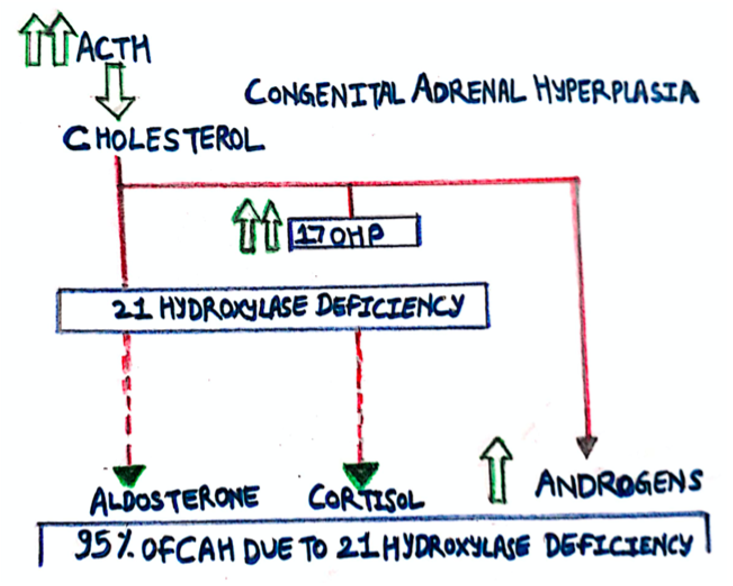There are host of conditions which may interfere with androgen signalling, which can lead to disorders of sexual development.
Congenital Adrenal Hyperplasia (CAH)
This is an autosomal recessive disorder which causes an excess of sex steroids with hyperplasia of both adrenal glands.
– It occurs due to a mutation in the enzymes which catalyse aldosterone and cortisol synthesis.
– Deficiency in these enzymes means that the precursors get shunted towards sex steroid production leading to increase in androgens, leading to the masculinisation of individuals
– In addition, Cortisol deficiency leads to high ACTH (lack of negative feedback), giving bilateral adrenal hyperplasia
Causes:
– Deficiency in 21-hydroylase (most common), 11-beta hydroxylase, 17-hydroxylase

General Symptoms:
– Low aldosterone –> salt wasting, hypovolemia, and hyperkalaemia
– Low cortisol –> life-threatening hypotension, weight loss and hypoglycaemia
– High androgens –> In females, gives ambiguous/virilised external genitalia (normal internal organs)
– In males, can lead to precocious puberty due to elevated androgen level
Symptoms by Mutation
Complications:
The lack of cortisol and aldosterone can lead to a Salt Wasting Crisis in the first weeks of life
– This leads to hypotension with weakness and circulatory collapse
– It also gives vomiting and diarrhoea
– This is more often seen in males with CAH as the condition is more likely to go undetected. It is usually seen individuals with the 21-hydroxylase deficiency.
Tests:
– Blood tests shows low Na, high K, and high 17a-hydroxyprogesterone.
– Genetic analysis can also be used
Management:
– Hormone replacement –> Aldosterone and Cortisol replacement to stop dehydration and hypotension
– In some XX women – surgery is used to reverse virilisation of the external genitalia
Androgen Insensitivity Syndrome
This is an x-linked recessive condition due to a mutation in the androgen receptor gene.
– This mutation reduces the ability of androgen to bind to the receptor and exert its effects
– This leads to failed external virilisation in XY individuals giving them a female phenotype
– This is because being female is default sex and needs testosterone to masculine it
– As these individuals have a Y chromosome with the SRY gene, then will have testicles, but the lack of testosterone means that they will have externally female sexual organs
– It can be complete or partial:
Complete Androgen Insensitivity
In this situation, the body is completely unresponsive to testosterone.
– This gives external female genitalia and sexual characteristics but male internal reproductive organs.
– These individuals are typically raised as females until puberty and may not even know they have the condition until symptoms start to show at puberty
Symptoms:
– Primary amenorrhoea –> no periods as these individuals lack a uterus
– Groin masses –> due to undescended testes
– May look more masculine in their appearance than XX girls
Partial Androgen Insensitivity
This means that the body is partially responsive to testosterone, but less so than in healthy males. These individuals may be raised as males or as females
Symptoms:
– Genitalia may look typically female, typically male, or ambiguous
– Born with male sex characteristics but often infertile and underdeveloped
– Can experience breast enlargement at puberty
Diagnosis:
– Karyotyping by buccal smear or chromosomal analysis reveals 46XY genotype
– Blood tests –> this shows testosterone, oestrogen, and LH levels (lack of negative feedback)
Management:
– For complete androgen insensitivity, the main idea is to raise the child as normal females
– Counselling –> this provides psychological support
– Surgery –> bilateral orchidectomy to remove undescended testes reducing risk of testicular cancer
– Hormone therapy –> oestrogen to feminise children
5-alpha reductase deficiency
This is an autosomal recessive disorder due to a mutation in the gene SRD5A2
– 5-alpha reductase is the enzyme that metabolises testosterone to dihydrotestosterone, its active product
– 5a-dihydrotestosterone is important for virilisation of external genitalia in the male (XY) fetus
– Deficiency of this enzyme leads to reduced levels of dihydrotestosterone and thus underdeveloped male genitalia
– However, during puberty, the surge in testosterone that occurs leads to rapid sexual maturation and masculinisation
Symptoms:
– Ambiguous genitalia in early childhood (hypospadias common)
– Children maybe brought up as girls
– Masculinisation at puberty –> rapid hair growth, voice deepens, increase in height, genitals enlarge
Diagnosis:
– Karyotyping shows XY chromosomes
– Hormone levels show normal testosterone, but low DHT (high T:DHT ratio)
Management:
– Hormone replacement therapy (male or female sex hormones dependent on gender role adopted by patient)
– May elect for genital surgery

